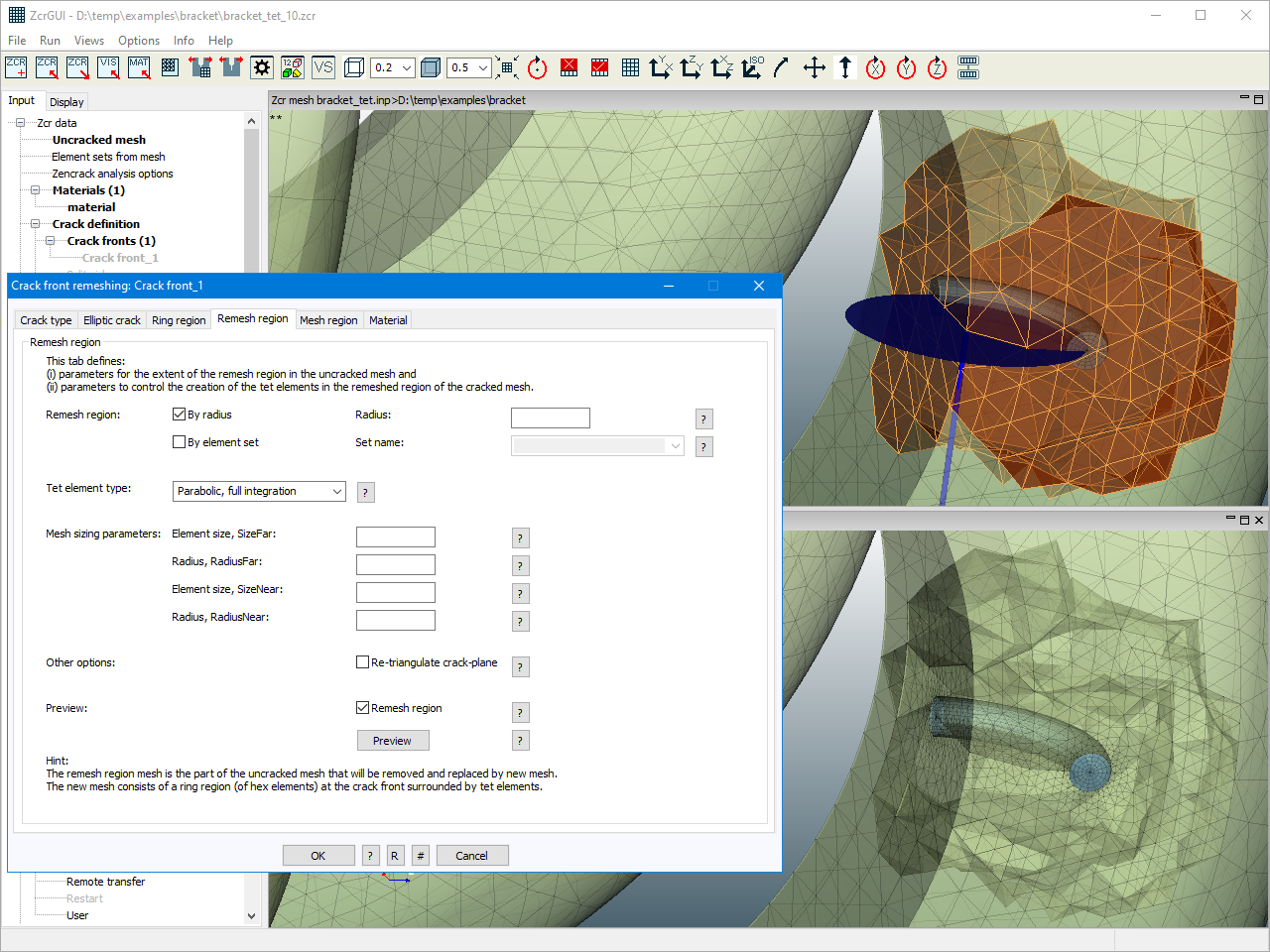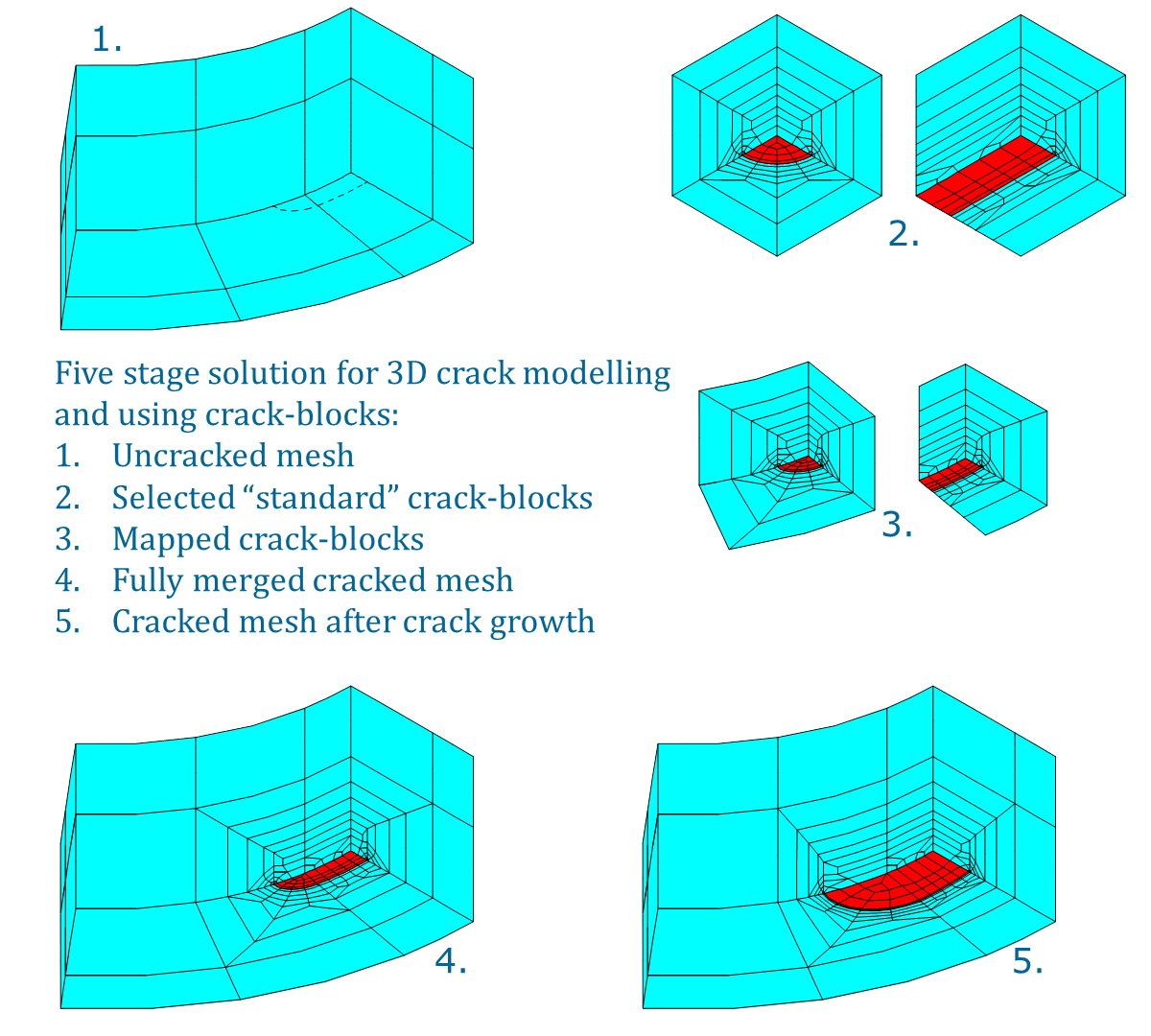Technical
Meshing Procedure
Overview
The generation of 3D finite element models suitable for analysis of cracks requires special attention to the meshing in and around the crack region. The crack front itself introduces a singularity into the stress and strain fields. The use of energy release rate and j-integral methods requires that there are "rings" of elements surrounding the crack front. To address both of these items properly requires the use of a focused mesh of hex elements (rather than tets) around the crack front.
In addition to these finite elements issues, the crack front presents topological problems. The initial crack front may be straight, a simple elliptic section, or a general curve in space.
To address these issues, Zencrack removes the onus of modelling the crack region from the analyst and requires instead that an uncracked mesh is supplied.
Zencrack was first released at the start of the 1990s. The methodology used for meshing was a crack-block approach in which elements of an uncracked mesh are replaced by one or more crack-blocks that include crack front details. The approach allows insertion of multiple crack fronts into the hex region of a 3D mesh. The uncracked mesh for this approach must be set up in a way that allows this replacement to provide the required initial crack and the potential for manipulating the mesh during crack growth.
The remeshing method in Zencrack was introduced in version 9.0-1. The aim of the remeshing process is to simplify the creation of an initial cracked mesh and to provide more flexibility in modelling crack growth. The geometric crack definition of the initial crack is fully independent of the underlying mesh (hex or tet) and can be generated very quickly.
Meshing Procedure - Remeshing
The remeshing method is based on the following approach:
- A crack front is to be inserted into a supplied uncracked mesh.
- A crack is defined on a geometry basis and is independent of the mesh.
- A region of the uncracked mesh is defined as the remeshed region. This region, identified by Zencrack, is removed and replaced by new mesh that includes the crack front.
- The new mesh consists of two parts:
- The ring region around the crack front. This is modelled with hexahedral elements and is the region used in contour integral calculations.
- The remesh region is the original remeshed region of the uncracked mesh, less the ring region. This is modelled with tetrahedral elements.
- The ring region, remesh region and the unmodified part of the original mesh are joined via tying constraints.
The remeshing method simplifies the definition of the initial crack and allows general crack shape development and non-planar crack surface development during crack growth calculations.

Meshing Procedure - Crack-blocks
A crack-block approach can be used to introduce one or more crack fronts into the uncracked mesh.
The term crack-block refers to a collection of brick elements stored as a unit cube. The arrangement of these crack-blocks is such that in their unit cube form they contain either a quarter circular or through crack front on one face. Part of this face is allowed to open up under loading giving the opening crack face within the crack-block.
The meshing procedure is one of replacement of one or more 8 or 20 noded brick elements in a user supplied uncracked mesh by crack-blocks. During the mapping process to introduce the crack-blocks the user can control the size and shape of the generated crack front section for each crack-block. The initial crack front derived from a quarter circular crack-block may be elliptic, for example. Crack-blocks can be connected together to form distinct crack fronts of the required size in the cracked mesh. In the example shown here, in which only one side of the crack front is modelled, two crack-blocks have been merged together to form a single crack front. In a more general case there may be multiple distinct crack fronts in a model.
For crack growth analysis an adaptive meshing algorithm is used. The updated crack front position and any non-planar crack history are used to re-insert the crack-blocks to create an updated crack position in the mesh. The crack shape that develops as the crack grows is a function of the initial shape, specimen geometry, applied loading and materials data.

Summary of Meshing Capabilities
Remeshing Method
- Geometry based definition of the initial crack, independent of the uncracked mesh
- Introduction of crack into an underlying hex or tet region of a mesh
- Use of linear of parabolic elements in the remeshed region
- Initial crack shape either elliptic or straight - elliptic may be surface-breaking or embedded
- Support for multiple crack fronts in a model
Both methods
- Quarter point or midside nodes in crack front elements
- Single or multiple nodes at each crack tip nodal position
- Automatic update of element properties, boundary conditions & loading in the crack region
- Generation of complete finite element analysis input file for cracked component including contour integral data
- Interpolation of specified nodal temperatures in the uncracked mesh to nodes in the cracked region of the cracked mesh
Crack-block Method
- Introduction of multiple crack fronts into an existing mesh of the intact component, replacing user-defined target brick element(s) with crack-blocks, each modelling a section of crack front
- Use of "large" crack-blocks and surface based tying to give greater flexibility in crack modelling
- Introduction of cracks in 8 or 20 noded brick meshes
- Library of crack-blocks in "unit cube space" for introduction of starter cracks
- Mapping from "unit cube space" to distorted shape of target element
- Automatic merging of crack-blocks into the mesh
- User defined initial crack shape
- Option to "reverse" the open and closed parts of a crack face
- Option to shift crack-block boundaries and relax the surrounding mesh to minimise element distortion.
Technical
Meshing Procedure
More in this category